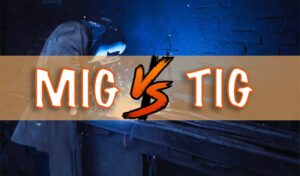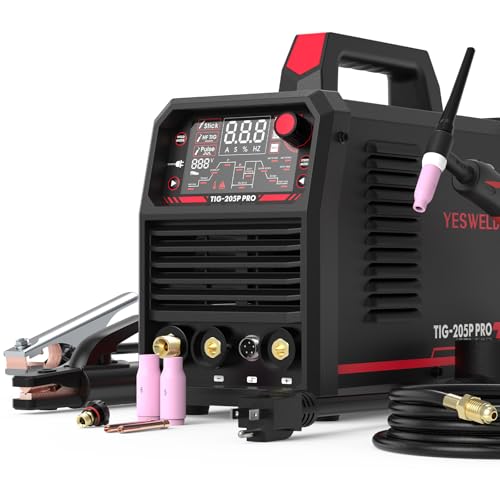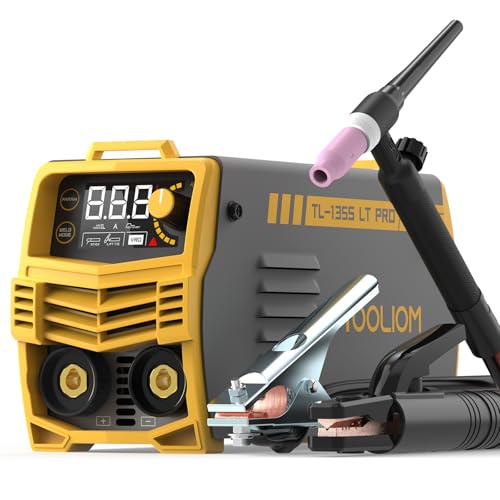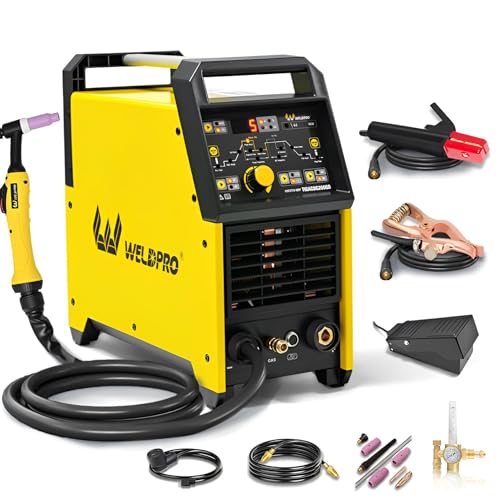 The prime difference between TIG and MIG welding is their welding techniques. Nowadays, many passionate welders or industry workers mostly prefer MIG and TIG welding processes.
The prime difference between TIG and MIG welding is their welding techniques. Nowadays, many passionate welders or industry workers mostly prefer MIG and TIG welding processes.
Arc welding procedures are different from each process because of how they complete a project. Selecting the right wedding process and choosing the best method is the key to make your welding workpiece perfect.
Therefore, both TIG and MIG welding varies from one another for their welding method, welding supplements, machines, positions, electric powers, gas, electrodes, and all.
Since the MIG and TIG welding processes are very popular. We will acknowledge the difference between TIG and MIG welding processes.
Table of Contents
The Ultimate Difference Between TIG and MIG Welding- MIG vs TIG Welding
Generally, arc welding contains various types of the welding process. For example, flux arc welding, metal-cored arc welding, tungsten gas arc welding, and so on. All these Arc Welding have different features and qualities.
However, MIG vs TIG welding has become an in-demand subject among professional, amateur, and hobbyist welders.
But, some welders out there need to use everything MIG, TIG, Arc, and Stick welding. All they can take a welding cart and make their welder machines transportation easier and flexible.
In the welding industry, the most prominent and famous welding technologies all over the world are MIG (Metal Inert Gas Arc Welding) and TIG (Tungsten Inert Gas Arc Welding).
Also, both of them are very alike with the process and techniques. So, they might as well be considered as a competent component in the welding world.
Since in TIG and MIG welding both complete the welding task using electric arc welding. Welders get confused over which one to choose as both are performing the same process.
But, the welding procedures are not the same at all. Both MIG and TIG have respectively separate classifications and characteristics. Which makes these welding better than each other for different types of welding processes.
Now let’s compare MIG vs TIG welding to know their similar qualities and also their different functions and features.
Comparison of MIG vs TIG Welding – Similarities
Before, we compare TIG and MIG welding with each other and get you to understand which one is compatible with you.
We will help you know all the similar natures of MIG and TIG that resemble With one another.
- Generally, MIG and TIG welding is electric arc welding processes. An electrical arc is connected with anode-cathode electrode and surface plat of the metal. That dissolves the iron base of the surface and also fuses the metal while merging the surface plate.
- Two of the procedures make use of uncoated electrodes. Since the substance of the electrode is individual in two abiding and cathode operations. The fluidity flux covered is not used in anode and cathode operations.
- Both MIG and TIG welding needs a supplement of gas for subsidiary sources. Because this system is unlike MM Arc Welding and FC Arc Welding operations, in which the shielding or covering gas gets produced. When the dissolving of the metals reacts with the flux availed electrode.
- In inert arc gas welding, the inert arc shielding gas is utilized for keeping the temper melted weld bead safe from getting contaminated or oxidized. While getting in contact with the air or water of the environment.
- Inert welding gases such as helium, argon, carbon dioxide, nitrogen, and the combination of this gas are applied to protect or shield the welded metals.
- Only heat or electricity conductive metals can be dissolved and joined with the MIG and TIG welding process. Every arc welding system is appropriate for welding conductive metals. But the Solid State Welding procedure can be used for welding non-conductive ions or metals.
Difference Between TIG and MIG Welding – MIG vs TIG Arc Welding Process
 There are some significant differences between MIG vs TIG welding process, as they use different electrodes and the work methods are also not at all similar.
There are some significant differences between MIG vs TIG welding process, as they use different electrodes and the work methods are also not at all similar.
Now, we will help you to know the difference between MIG
and TIG welding.
Welding Electrode:
MIG ( Metal Inert Gas) Arc welding works with a consumable electrode, which acts as a filler and repeatedly gets stuffing into the welding surface from the wire lead pool.
TIG (Tungsten Inert Gas) Arc Welding uses a non-consumable electrode that does not partake in the welding process and stays unchanged and unscathed.
User-Friendly Electrode:
The consumable electrode supplies the essential filler for welding seams. For that, itself gets dissolved as a metal filler, which is needed to be put inside the hole of the surface metal. So, that it can fill the gaps or crannies.
Non-consumable electrodes do not meltdown in the welding process and possess a high melting point which is inevitable for pure metal tungsten welding.
Additional Filler:
As well the process of MIG welding does not need to gather or arrange any more filling resources as consumable electrodes fulfill this necessary task.
In the TIG welding process, it is required to prepare additional filler metals individually beforehand.
Supporting Welding Modes:
Among the three welding modes. MIG is appropriate for homogeneous welding mode. But it is not applicable in the other autogenous mode or heterogeneous mode. Because the two modes bear on weld filler supply naturally.
TIG is specifically fitted with autogenous welding mode. But, this can also be applicable for both homogeneous and heterogeneous mode weldings. As these have added reserved welding filler supplies.
Metal Types of Welding Electrode:
Configuration of the electrode is chosen formulated on the original parent metal. Generally, the metallurgical configuration of the metal of the electrode is equivalent to the surface base metal.
For TIG electrodes, the electrode metal has always been selected for tungsten, combined with a tiny portion of other mixed metal elements like nickel.
Electrode Figures:
Consumable filler electrode is structured with a small form on a diameter scale of 0.5 to 2 millimeters. And the length is very tall with hundreds of meters cord coiled in the wire pool.
The non-consumable electrode is a 60 mm short lengthy rod and the figure is of 1 to 3 millimeters diameter.
Duration:
Since it is very long, this electrode-cum-filler can be utilized for a long time. Yet it will not need any repair or change.
As it is small-sized. It gets vaporized while welding. Even though it is made of pure iron it has to be replaced occasionally. Which postpones the welding process for a short time.
System of Electric device:
The MIG process is normally put through AC circuit polarity or DC electrode positive polarity(DCEP). That’s how the consumable electrode gets dissolved and fixed in gaps very fluently and swiftly.
The TIG process is usually accomplished through AC polarity or DC electrode negative polarity (DCEN) for enlarging the life expectancy of electrodes.
Filler Disposition:
The standard of filler disposition is very high quality and also highly operative.
The standard rate of filler deposition is low and a bit lowly operative.
Spatters in Welding:
This welding frequently creates spatter sprays in the welding.
Which results in a waste of expensive filler metal. Tungsten welding doesn’t create spatter spray.
Quality of welding:
Visual appearance and quality of welding are not very appealing.
Appearance is top-notch and the welding procedure leads to defect less flux and joints.
Inclusion Defects:
MIG does not have a tungsten inclusion disadvantage.
TIG causes tungsten inclusion, because of broken or dissolved tungsten and creates a great loss.
So, both welding processes have their amazing features and some small problems.
FAQ
Q: Can I use iron electrodes in TIG welding?
A: No, you cannot use iron electrodes for TIG welding as tungsten is a pure metal and of high melting point. You will have to use an electrode that is made of tungsten and other metal mixtures.
Q: Do I have to buy filler metals in MIG welding?
A: You don’t have to buy fillers for MIG welding. Since electrodes used in MIG also function as a filler.
Conclusion:
Both MIG and TIG arc welding have some same and some separate features. Else, The welding process also gives outstanding and productive outcomes in their suitable welding task.
However, you need to decide what will be the best welding process. Alternatively, what rather metal you will be melting or joining. Also, what kind of welding procedure is appropriate for you to handle.
Thus, welding comes with great hard work and amusing experience.








![ARCCAPTAIN 165A MIG Welder 110V/220V, 2025 Newest [Large LED Display] 4 in 1 Gasless/Gas MIG/Lift...](https://m.media-amazon.com/images/I/51GW2TUAy1L.jpg)